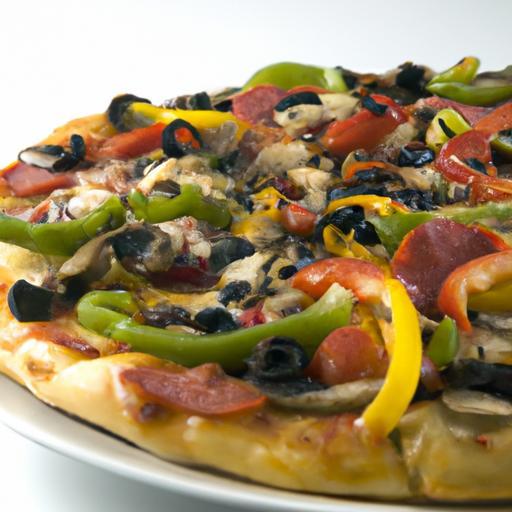There’s something almost alchemical about the perfect pizza-crisp, blistered crusts that crackle beneath bubbling, golden cheese, and toppings cooked just right. While the magic often seems to come from a secret sauce or an age-old family recipe, the real hero of this culinary spell might just be hidden beneath the pie: the baking surface. Enter the world of pizza stones and steels, two unsung champions that transform home ovens into artisanal pizza ovens. In this article, we’ll unlock the secrets behind these kitchen tools, exploring how their unique properties harness heat to craft that enviable crust and elevate your homemade pizza to pizzeria-level perfection. Ready to turn up the heat and dive into the science and artistry of stones and steels? Let’s get cooking.
Unlocking Perfect Pizza: The Magic of Stones and Steels truly begins with understanding the essential science behind heat retention and distribution in your oven. Using the right baking surface can elevate your pizza from good to unforgettable, thanks to the way heat transfers into the crust, creating that coveted crispy yet tender bite. Whether you wield a pizza stone or a steel, mastering their distinct thermal properties unlocks new levels of flavor and texture in every slice.
Prep and Cook Time
- Preparation: 20 minutes (plus dough rising time)
- Cook Time: 8-12 minutes
Yield
Serves 4 classic 12-inch pizzas
Difficulty Level
Medium – perfect for home cooks eager to refine their craft
Ingredients
- 500g all-purpose flour, sifted for airy dough
- 325ml lukewarm water (around 100°F/38°C)
- 7g active dry yeast
- 10g fine sea salt
- 15ml olive oil, plus extra for drizzling
- 200g fresh mozzarella cheese, torn into bite-sized pieces
- 150g crushed San Marzano tomatoes, well-drained
- Fresh basil leaves for garnish
- Coarse cornmeal, for dusting
Instructions
- Activate the yeast: In a small bowl, dissolve 7g active dry yeast in 100ml lukewarm water. Let stand 5-10 minutes until foamy, signaling active fermentation.
- Mix the dough: In a large mixing bowl, combine all-purpose flour and sea salt. Make a well in the center, pour in the activated yeast mixture, remaining 225ml water, and 15ml olive oil. Stir gently until a shaggy dough forms.
- Knead to perfection: Transfer dough to a floured surface and knead for 10 minutes, until it becomes smooth and elastic. This develops gluten, key for a chewy crust.
- First rise: Place dough in a lightly oiled bowl, cover with damp cloth, and leave in a warm spot for 1-1½ hours, or until doubled in size.
- Preheat your baking surface: Place your pizza stone or steel in the oven’s lowest rack. Preheat the oven to 500°F (260°C) for at least 45 minutes for optimal heat retention.
- Shape your dough: On a cornmeal-dusted peel or baking sheet, gently stretch the dough into a 12-inch circle, leaving a natural edge for the crust. Avoid excessive flour to preserve texture.
- Build your pizza: Spread an even layer of crushed San Marzano tomatoes onto the dough, leaving the edges clear. Scatter torn mozzarella pieces and drizzle lightly with olive oil.
- Bake to crisp perfection: Slide the pizza onto the heated stone or steel. Bake for 8-12 minutes, rotating halfway for even cooking. Watch for a golden crust and bubbling cheese.
- Garnish and serve: Remove from oven, scatter fresh basil leaves, and drizzle a touch of olive oil. Slice and serve immediately for maximum flavor and texture.
Tips for Success: Seasoning and Maintaining Your Baking Surface
Seasoning your pizza steel or stone is vital to building a naturally non-stick surface. For pizza steels, a thin coat of high smoke point oil (like flaxseed) baked at high temperature creates a durable patina. Stones generally require less seasoning but do need thorough preheating and regular cleaning to avoid moisture buildup that weakens heat retention.
Always clean your stone or steel without soap; a stiff brush or scraper will suffice to remove charred residue. Avoid rapid temperature changes-let the surface cool gradually to prevent cracking or warping.
The Heat Advantage: Why Choose Steel or Stone?
A pizza steel absorbs and radiates heat more efficiently than stone due to its density and thermal conductivity, resulting in a sharper crust crunch and faster bake times. Stones, composed of ceramic or cordierite, excel at even heat retention but deliver a slightly softer crust. Your choice should align with your preferred crust texture and oven performance.
Mastering Dough and Bake Times for Crispier, Tastier Pizza
Proper dough hydration and fermentation are cornerstones for an airier crumb and crispy crust. Long fermentations – even cold fermenting for 24-48 hours – enhance flavor and gluten strength, while hydration levels of 65-70% ensure moisture without sogginess. Baking at ultra-high heat with a preheated baking surface guarantees rapid moisture evaporation and caramelization, locking in flavor.
Serving Suggestions
For an authentic Italian experience, pair your pizza with a simple arugula salad tossed in lemon vinaigrette. Garnish slices with a sprinkle of crushed chili flakes or a drizzle of aged balsamic reduction. Serve with a side of garlic roasted mushrooms or a chilled glass of crisp Pinot Grigio.
| Nutritional Info (per slice) | Calories | Protein | Carbs | Fat |
|---|---|---|---|---|
| Classic Margherita | 280 | 12g | 32g | 9g |
Explore advanced dough techniques to enhance your pizza making journey. For scientific insights on thermal conductivity in cooking appliances, visit ScienceDirect – Thermal Conductivity.

Q&A
Q&A: Unlocking Perfect Pizza – The Magic of Stones and Steels
Q1: Why do professional pizzaiolos swear by stones and steels?
A: It’s all about heat – not just any heat, but the kind that mimics the blazing floors of traditional wood-fired ovens. Stones and steels retain and radiate intense heat evenly, creating that coveted crispy crust and perfectly cooked topping that ordinary baking sheets simply can’t deliver. They’re the secret sauce for achieving restaurant-quality pizza at home.
Q2: What’s the difference between a pizza stone and a pizza steel?
A: Think of stones as the old-world charm – usually made from ceramic or cordierite clay, they soak up moisture and deliver a crispy bottom. Steels, on the other hand, are metallic powerhouses. They heat up faster and maintain higher temperatures, giving you a crispier crust with a little more snap. While stones excel at moisture absorption, steels boast superior heat conductivity-a dynamic duo of pizza perfection!
Q3: How do stones and steels transform the baking process?
A: They flip the oven’s weak spot-its uneven, often insufficient floor heat-into a super-hot, stable cooking platform. This high-intensity base jumpstarts the dough’s rise and browns it beautifully while locking in chewiness and flavor. It’s like having a blazing hearth nestled right inside your conventional oven.
Q4: Can I use a pizza stone or steel for other baked goods?
A: Absolutely! Stones and steels excel at baking artisanal breads, crisp flatbreads, and even roasting vegetables. Their radiant heat ensures even cooking and crisp textures, elevating almost anything you bake or roast.
Q5: How do I care for my pizza stone or steel?
A: Simplicity is key here. Avoid soap-just scrape off any leftover crumbs and wipe with a damp cloth. Stones are porous like a sponge, so soap can sneak in and flavor your pizza; steels don’t absorb but still thrive best with minimal cleaning. Also, sudden temperature changes are their enemy-let them cool naturally after each bake.
Q6: Is preheating essential?
A: Yes! Patience pays off. Preheat your stone or steel for at least 30-45 minutes at maximum oven temperature. This ensures it’s scorching hot, ready to deliver that instant oven spring which makes crusts light, airy, and crisp.
Q7: Any pro tips for using stones or steels like a pizza wizard?
A: Here’s the trade secret: slide your pizza onto the stone or steel with a peel dusted lightly in flour or cornmeal to prevent sticking. If you’re using a steel, consider broiling at the end for a blast of direct heat to perfect char and bubbles. And don’t overload toppings-light and balanced lets the heat do its magic.
Q8: Can I expect better results with a steel than a stone?
A: Both are champions, but steels generally deliver faster, hotter, and more consistent heat transfer, making them ideal for those striving for a crispier crust with less preheat time. Stones, however, offer a gentle, moisture-absorbing bake that some pizza lovers swear by. It’s your personal pizza style calling – embrace the magic that suits your soul!
Unlocking pizza perfection is a delicious journey – stones and steels are your enchanted tools, turning humble dough into culinary gold. Ready your oven, harness their heat, and embark on your own pizza adventure!
In Summary
As the last slice disappears and the aroma of perfectly baked crust lingers in the air, it’s clear that the secret to pizza perfection isn’t just in the dough or toppings-it’s in the very surface that cradles your pie. Whether you choose the radiant heat of a pizza stone or the swift, intense sizzle of a steel, unlocking the magic beneath your pizza reveals a world of crispiness, flavor, and texture previously reserved for pizzerias. So next time you fire up your oven, remember: the journey to perfect pizza begins with the right foundation. Elevate your pizza game, and let stones and steels transform your kitchen into a haven of irresistible, golden-crusted marvels. Your taste buds will thank you-slice after glorious slice.


